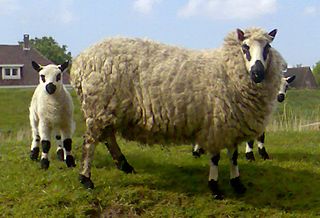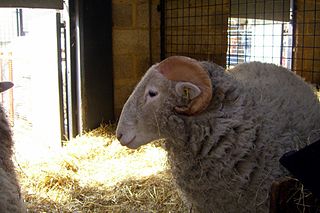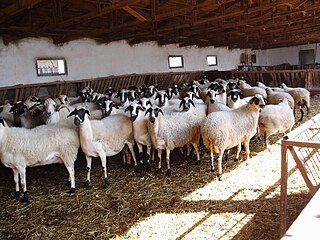Related Research Articles
The Perendale is a breed of sheep developed in New Zealand by Massey Agricultural College for use in steep hill situations. The breed is named after Sir Geoffrey Peren, and it achieves its aims by being the offspring of Romney ewes and Cheviot rams with sturdy legs. It is raised primarily for meat.

The Lincoln, sometimes called the Lincoln Longwool, is a breed of sheep from England. The Lincoln is the largest British sheep, developed specifically to produce the heaviest, longest and most lustrous fleece of any breed in the world. Great numbers were exported to many countries to improve the size and wool quality of their native breeds. The versatile fleece is in great demand for spinning, weaving and many other crafts.

The Border Leicester is a British breed of sheep. It is a polled, long-wool sheep and is considered a dual-purpose breed as it is reared both for meat and for wool. The sheep are large but docile. They have been exported to other sheep-producing regions, including Australia and the United States.

The Shropshire breed of domestic sheep originated from the hills of Shropshire, and North Staffordshire, England, during the 1840s. The breeders in the area used the local horned black-faced sheep and crossed them with a few breeds of white-faced sheep. This produced a medium-sized polled (hornless) sheep that produced good wool and meat. In 1855 the first Shropshires were imported into the United States (Virginia). This breed is raised primarily for meat.

The Hampshire Down or Hampshire is a British breed of sheep. It originated in about 1829 from cross-breeding of Southdowns with the Old Hampshire breed, the Wiltshire Horn and the Berkshire Nott, all horned, white-faced sheep — these were native to the open, untilled, hilly stretch of land known as the Hampshire Downs. It is much used as a terminal sire.

The Romney, formerly called the Romney Marsh sheep but generally referred to by the local farmers as the Kent, is a breed of sheep originating in England. The Romney is a "long-wool" breed recognized in England by 1800. Exported to other continents, the Romney is an economically important sheep breed, especially to the sheep-meat and wool export trades of New Zealand.

The Bluefaced Leicester (BFL) is a longwool breed of sheep which evolved from a breeding scheme of Robert Bakewell, in Dishley, Leicestershire in the eighteenth century. First known as the Dishley Leicester, and then the Hexham Leicester, because of the prevalence of the breed in Northumberland, the name Bluefaced Leicester became known at the beginning of the 20th century. In the 1970s, the Bluefaced Leicester was exported to Canada. Exported frozen semen from the United Kingdom is now used to expand the genetic diversity in Canada and the United States. This breed is raised primarily for meat, but their fleece is becoming increasingly popular for handspinning. Bluefaced Leicester sheep may also have brown on their face. The sell record has been set by a brown ram lamb selling for 23,000 guineas.

The Shetland is a small, wool-producing breed of sheep originating in the Shetland Isles, Scotland, but is now also kept in many other parts of the world. It is part of the Northern European short-tailed sheep group, and it is closely related to the extinct Scottish Dunface. Shetlands are classified as a landrace or "unimproved" breed. This breed is kept for its very fine wool, for meat, and for conservation grazing.

Welsh Mountain sheep are small, hardy sheep from the higher parts of the Welsh mountains. The males have horns, and the females are polled (hornless); they have no wool on the face or legs, and they have long tails. There are a number of varieties, bred for sheep farming in Wales. These are mainly colour variations, but some are being developed as separate breeds.

The Clun Forest is a breed of domestic sheep originating from the area surrounding the Clun Forest in Shropshire, England. Similar to many of the British breeds of upland sheep, Clun Forest are hardy, adaptable, good foragers, and are long–lived. With sleek heads and wide pelvic structures, Clun Forest ewes lamb easily. The breed has a short to medium–length wool and dark brown faces. They are a multi–purpose animal, kept for meat, wool, and milk. Like other dark faced sheep, Clun produce quality lamb and mutton. However, in contrast to more common meat breeds such as Suffolks, their wool is free of undesirable black fibres and kemp, and is suitable for handspinning. The breed's alert and stylish appearance, together with its reputation for hardiness and fecundity have made it popular with hobby farmers and large commercial flock owners alike. The Official Clun Sheep Breeders Society Show & Sale for males and females is held annually in early September at Ludlow livestock market by McCartneys.
The California Red is a breed of domestic sheep developed in the United States.

The Kerry Hill is a breed of domestic sheep originating in the county of Powys in Wales. It derives its name from the village of Kerry (Ceri), near Newtown. Kerry Hill sheep have a distinctive and unique coloration, with a white face bearing black markings around the mouth, ears, and eyes. Both rams and ewes are polled. Their wool is white, and their legs are white with black markings. First mentions of the breed date back to the early 19th century, and today it is distributed throughout the United Kingdom, Ireland, the Netherlands, Germany and Denmark. Though still not very numerous, the breed was removed from the records of the Rare Breeds Survival Trust watchlist in 2006. This breed is primarily raised for meat.

The Whitefaced Woodland is a sheep breed from the Woodlands of Hope an area in the South Pennines in England. It is a combination of two breeds, the Woodland and the Penistone sheep after the Yorkshire town where sheep sales have been held since 1699. It is thought to be closely related to the Swaledale and the Lonk. Substantial commercial flocks of the Whitefaced Woodland are kept in its region of origin, but it is listed as a vulnerable breed by the Rare Breeds Survival Trust, since there are fewer than 900 registered breeding females in Great Britain.

The Racka or Hortobágy Racka Sheep is a breed of sheep known for its unusual spiral-shaped horns. These unique appendages are unlike any other domestic sheep horns, and may grow up to 2.0 ft (0.61 m) long. The smallest standard length is 20 in (51 cm) for rams and 12–15 in (30–38 cm) for ewes.
The Devon Closewool is a British breed of domestic sheep. It is distributed almost exclusively on Exmoor in North Devon, in south-west England. It is raised primarily for meat.

The Beulah Speckled Face is a breed of domestic sheep originating in the United Kingdom. Having been bred in the uplands of Wales for more than a hundred years, a breed society was officially formed in 1958. This breed is most common in Eppynt, Llanafan Fawr, Abergwesyn, and Llanwrtyd Wells, and it is little known outside Wales. The origins of the breed are unclear; it may be a truly native breed that has been selected to suit the local environment for centuries. The breed is named for its distinctly patterned black and white face, which is free from wool. The ewes, which are naturally polled, are often crossed with lowland rams such as the Suffolk, Texel or Bluefaced Leicester to breed mules, and to produce market lambs for meat. When bred pure, the lambs do not meet today's export demand for lean, fast-growing sheep. However, the ewes make good mothers and produce plenty of milk.

North Country Cheviot is a common breed of sheep raised mainly for meat production. Originated from Scotland.

The Border Cheviot, also known as the South Country Cheviot, is a breed of domesticated sheep from the UK. It is native to the Cheviot Hills between Scotland and England. Recognized as early as 1372, the breed is reported to have developed from sheep that swam ashore from shipwrecked Spanish ships that fled northward after the defeat of the Armada. This breed is prized for its wool but bred primarily for meat.

The Chios is a breed of domestic sheep with specific unknown origins. It is classified as a semi-fat tailed breed. The Chios are bred mainly for their milk production. Although there is speculation that this breed may have been crossed with Kivircik and Dagliç, it is commonly accepted that it originated on the Greek island of Chios.

The Canadian Arcott is a breed of domestic sheep native to Canada. The latter half of its name is an acronym for the Animal Research Centre in Ottawa, where it was developed along with the Rideau Arcott and the Outaouais Arcott. This breed was a result of a crossbreeding program of Suffolk (37%), Ile de France (28%), Leicester (14%), North Country Cheviot (7%) and Romnelet (6%); the remaining 8% was contributed from Shropshire, Lincoln, Southdown Dorset, East Friesian, Finnsheep and Corriedale.
References
- 1 2 3 "Brecknock Hill Cheviot". Oklahoma State University, Dept. of Animal Science. Archived from the original on 2008-11-03. Retrieved 2009-06-18.
- ↑ "Brecknock Hill Cheviot/United Kingdom". Domestic Animal Diversity Information System. Retrieved 2009-06-18.
- 1 2 "Miniature Cheviot". Sheep101.info. Retrieved 2009-06-18.